Now that we’ve learned about traditional composting and worm composting, let’s talk about bokashi composting. Since this is a subject that I am weak on, I thought it would be best to get an expert to help us out on the subject. I worked out a deal with bokashiliving.com and they graciously provided us with all the knowledge we need to get started with a bokashi composting system. Please visit their website for more info and a great selection of starter kits.
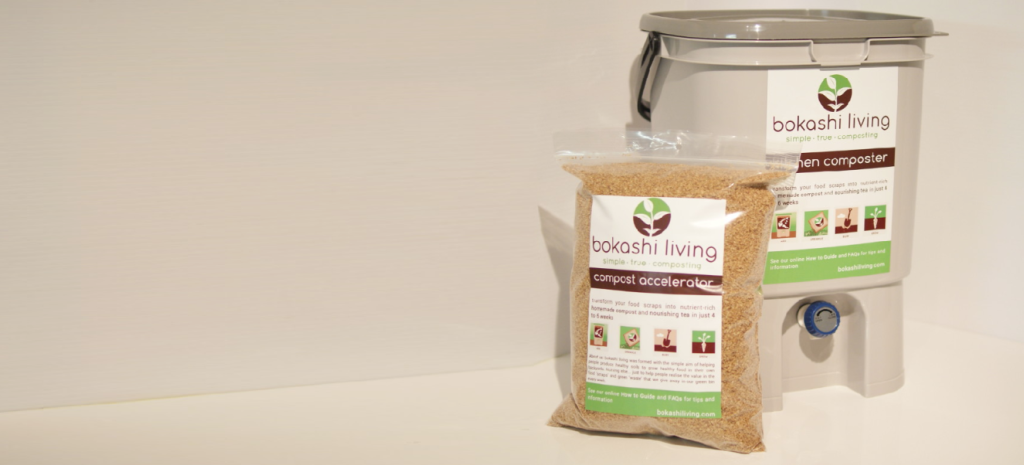
What is bokashi composting?
Traditional composting uses aerobic bacteria to break down your food scraps and garden waste. A Bokashi composting system uses an-aerobic bacteria and yeasts to break them down. This works well for indoor small scale composting. All you need is 1 or 2 small buckets in your kitchen for your waste. You don’t have to rotate or aerate a big pile either. If you live in a dry climate this is also helpful, because in the desert, a traditional compost pile dries out easily. Bokashi composting is a great way to conserve water. The only down side is that you will need to bury the finished bokashi compost, so it can finish off and fertilize your plants.
Benefits of bokashi composting
A bokashi composting system quickly and easily converts all food waste into highly productive compost. The key to the bokashi process is fermentation. Through fermentation, bokashi composting generates the specialized microbes, yeast, and fungi that are the primary building blocks of a healthy and productive soil structure.
With bokashi, many of the challenges associated with ‘traditional’ composting are eliminated. While traditional back-yard composting typically works on select food scraps only, bokashi composting works on ALL food scraps: cooked foods, dairy, meat, grains, pasta, fruits and veggies, the lot of it. And this is the key to its popularity.
In addition, it is fast, easy, produces no foul odor, will not attract pests and the majority of the process is completed conveniently right in one’s own kitchen. The bokashi compost produced from your food waste is richer in effective beneficial micro-organisms than any other form of compost and your garden will love it.
It’s so simple! Transform ALL of your food scraps to compost in just 4-6 weeks in four easy steps.

Top 10 reasons why you should use a bokashi composting system:
1. It’s fast
The bokashi composting process will transform your food scraps to nutrient rich compost in just 4-6 weeks. That means that just over a month after you have thrown away your carrot peelings or your half eaten sandwich, you will be able to use it as compost in your garden.
2. It’s easy
The bokashi process is easy from start to finish. It is easy to set up; you just need a bokashi kitchen composter and some bokashi bran (all available at www.bokashiliving.com/shop). It is easy to do; simply add your food waste to your bokashi compost bin, sprinkle on a tablespoon or two of bokashi bran (aka bokashi powder or bokashi mix) and seal the lid. It is also easy to finish; once your bin is full do nothing for two weeks and then dig a trench in your garden (or compost pile), bury the bokashi pre-compost and then do nothing for another 2 weeks. Your compost is then ready to be planted in.
3. You can compost all of your food waste
The bokashi system can be used for all of your food waste. Vegetable peelings, fruit skins and peelings, leftover salads and everything that you would throw in a ‘traditional composter’ are all great in your bokashi bin. You can also add cooked food, meat, dairy, baked goods (bread, cookies etc), egg shells, bones… all food waste, without concerns about attracting pests.
4. No putrid smells
Bokashi composting isn’t completely odorless but the smell shouldn’t be unpleasant. It smells a bit like pickles or the yeasty smell from brewing beer. The bin is tightly sealed and can be kept inside your kitchen where it is easily accessible to your food waste without causing any bad smells.
5. No pest problems
Many people may have given up on home composting after years of (unsuccessfully) battling with pests in the compost heap. Rats, raccoons, flies, mice, foxes, and even bears can cause havoc with a compost pile and are not welcome visitors to most gardens. Traditional compost piles rely on your food scraps rotting over time which can take around a year to convert into usable compost. This gives local wildlife plenty of time to find your compost pile and identify it as a food source. Adding meat, cooked food, egg shells, dairy and bread to your traditional compost pile is often a disaster.
The bokashi process ferments (or pickles) your food scraps using a unique blend of bacteria and microbes. The sweet, pickled smell of the bokashi pre-compost can be safely buried in your garden, compost pile or containers without attracting any pests. The bokashi composting process allows you to compost all of your food waste without the worry of attracting pests.
6. Suitable for all sizes of gardens, patios and balconies
Bokashi composting is successful on any scale and the process can be scaled up or down to meet your needs. Whether you are producing only a few 100 grams of food waste a day or a few 100 kilograms of food waste a day the process is the same and the results will be identical.
7. No loss of nutrients or water
The bokashi fermentation process is completed inside a closed container; therefore there is no opportunity for the nutrients or water to be lost. For example, there is no chance for nutrients to be leached out by rainwater infiltration and runoff. In addition, none of the carbon or nitrogen is gassed off into the atmosphere from the sealed bokashi compost bin. The sealed bin means there is no evaporation so all of the moisture from your food waste is returned to your soils either through the bokashi tea or through the bokashi pre-compost.
8. It isn’t seasonal
The bokashi process is successful throughout the year. The pre-compost takes a little longer to fully breakdown during the colder winter months. However, you’re not likely to be planting on it in the middle of winter so you can probably happily leave it for a few extra weeks. You can continue the process of collecting, fermenting and burying your food waste 365 days a year.
9. Negligible greenhouse gases emitted
Studies show that traditional composting potentially recycles around half (or less) of the carbon into the soil. Even under optimum conditions, traditional composting emits greenhouse gases. Bokashi composting, on the other hand produces little, or no, greenhouse gases.
“…bokashi fermentation does not produce measurable gas emissions in its conversion of organic waste into a nutrient-rich end product that can be used to support plants and crops.” (Green, 2009) 1
More scientific research is needed but take a look at your bokashi living kitchen composter. Does it swell over time because the fermentation process is off-gassing? No. This strongly suggests that very little, if any gases are being produced.
And if carbon isn’t being released into the atmosphere this means that more of the goodness from your food scraps is getting into your soil.
10. It adds beneficial bacteria and by-products to your soil
The fermentation process doesn’t stop instantly when you add your pre-compost to your soil or compost heap. After 2 weeks of fermentation in your indoor kitchen composter, the number of beneficial microbes in your food scraps has increased immensely. Adding the pre-compost to your soil will also add all of these beneficial bacteria. These microbes can help to break down harmful chemicals and suppress pathogens within your soil or compost pile. You may start to notice the familiar white mold on the surface of your soil after you have buried your bokashi pre-compost. This is evidence that the beneficial bacteria have survived and are thriving in your soil.
The microbes used in Bokashi Living’s bokashi bran are all naturally derived and occur in soils around the world.
The fermentation process also produces a number of other beneficial products; alcohol, amino acids, organic acids and anti-oxidation substances. All of these by-products add nutrient value to the pre-compost and the bokashi tea.
How to compost with bokashi

The bokashi composting process is simple and easy. Follow these four simple steps and you can enjoy creating homemade compost in just 4-6 weeks.
Step 1: Add
 The first step is to add you food waste to your bokashi kitchen composter. Fruits, vegetables, cooked food, meat, bones, dairy and baked goods are all fine to add to your bokashi kitchen composter.
The first step is to add you food waste to your bokashi kitchen composter. Fruits, vegetables, cooked food, meat, bones, dairy and baked goods are all fine to add to your bokashi kitchen composter.
To be honest, it’s probably easier to just think about what should not go in the bokashi kitchen composter. That list is much shorter.
Things to keep out of your bokashi kitchen composter:
- Moldy or rotten food. These may introduce too much blue/green mold and may turn your bokashi bin bad. An occasional moldy grape or apple core is fine but don’t overload your bokashi bin with rotten items. If you are adding small amounts of blue/green mold to your bin remember to add a little extra bokashi mix or bran at the same time.
- Excess liquids including grease and oil. Too much liquid prevents the good bacteria from thriving. Small amounts are acceptable.
We also recommend keeping cut flowers and garden waste out of your bokashi bucket. These will happily break down using the bokashi process but will take up a lot of space in your bokashi compost bin. Cut flowers and garden waste don’t add as much nutrient value as food waste. We suggest you save space in your bokashi compost bin for items that are going to add lots of nutrients to your soil and those that would be hard to compost otherwise.
Remember to chop your food waste into 1-2″ pieces. Larger pieces are OK but may take longer to ferment. Smaller pieces create a larger surface area for the bokashi microbes to get to work on.
The bokashi process is anaerobic and so the less fresh air in the bin, the better. Try not to open the lid more than necessary. We would suggest that you add your food waste in batches. Keep a convenient container on the kitchen counter to collect your food waste. Emptying this container into your bokashi kitchen composter every day, or every other day, is best.
Once you’ve added your food waste, press it down using a kitchen plate, piece of cardboard or plastic bag to expel air. Leave the plate, cardboard or bag in place to keep air away from the food waste.
Step 2: Sprinkle
 Each time you add food waste to your bokashi compost bin you need to sprinkle on some bokashi bran (aka bokashi powder or bokashi mix). The bokashi bran is a mix of microbes that accelerates the composting/fermenting process. For each 1″ of food waste, sprinkle 1 to 2 heaping tablespoons of bokashi bran.
Each time you add food waste to your bokashi compost bin you need to sprinkle on some bokashi bran (aka bokashi powder or bokashi mix). The bokashi bran is a mix of microbes that accelerates the composting/fermenting process. For each 1″ of food waste, sprinkle 1 to 2 heaping tablespoons of bokashi bran.
You can never add too much bokashi bran. Be more generous if you are putting meat, dairy, bones or cooked food into your kitchen composter.
Repeat this process every day, or every other day, until your bokashi kitchen composter is full. The average family will take about 2 weeks to fill a bin. Don’t worry if it takes longer than this, it will just give your food waste more time to ferment. If you fill the indoor kitchen composter in less than 2 weeks then simply add a third (or fourth) bin to your bokashi system so that you can continuously collect your food waste.
Once the bin is full, keep the lid sealed for 2 weeks to complete the pre-compost fermentation process. During this time you can start to fill your second kitchen composter.
Avoid exposing your bokashi compost bin to extreme temperatures and direct sunlight. Room temperature is ideal for the kitchen composter. Cooler temperatures may require more time for fermentation to complete. As the kitchen composter will not smell or attract wildlife, most people keep their bokashi compost bin in your kitchen.
Use the spigot on your bokashi compost bin to drain the bokashi tea every other day and use the tea within a couple of hours. Bokashi tea is a fantastic fertilizer for your house plants and garden. Dilute the bokashi tea with water (at least 100 to 1) before using, as the bokashi tea is acidic. See below for more details on bokashi tea.
Step 3: Bury
 After your food waste has fermented for at least 2 weeks you are ready to bury your bokashi pre-compost in your garden, compost heap or container.
After your food waste has fermented for at least 2 weeks you are ready to bury your bokashi pre-compost in your garden, compost heap or container.
Firstly, check that your bin has fermented successfully. After 2 weeks you should see white mold on the surface of the waste and/or smell a sweet and sour pickle-like smell. These are indicators of successful fermentation.
If you see blue /green mold or your bin has a putrid smell then your bin has gone bad. For more details on how to prevent your bin from going bad read through the troubleshooting guide below.
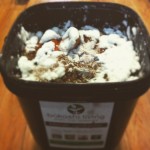 Assuming that you have white mold and/or a sweet-smelling bin, you are ready to bury your pre-compost. You have a few options for your pre-compost. The three most common methods are:
Assuming that you have white mold and/or a sweet-smelling bin, you are ready to bury your pre-compost. You have a few options for your pre-compost. The three most common methods are:
- trench method,
- compost burial
- soil factory.
Trench method of burying
Firstly, find an area of your garden where you wish to enhance the soil. Dig a trench approximately 12″ deep, 12″ wide and 24″ long. If you don’t have space for a large trench you can bury pre-compost in multiple holes.
Empty your pre-compost into the trench. Cover with 1-2″ of soil and mix, making sure there are no large lumps of pre-compost. Cover with the rest of your soil, so at least six inches of soil covers your pre-compost.
If you have particularly inquisitive wildlife who will disturb freshly dug soil looking for grubs, we would recommend covering the area with the newly buried pre-compost with netting to discourage wildlife.
Watch the video below to learn more about the trench method.
Burying in your compost pile
This is a popular method, particularly during winter months when your ground may be frozen or covered in snow. The bokashi microbes will reinvigorate life within the compost pile, and you will see a noticeable improvement in the quality of the compost.
This approach is similar to the trench method but instead of burying directly into your garden you bury the pre-compost into your compost pile. Dig a hole in your compost pile, mix in the pre-compost and then cover with at least 6″ of compost material.
Watch the video below to learn more about the compost pile method.
Soil factory
A soil factory can be made from any large plastic storage box with a well fitting lid. Put a few generous scoops of regular garden soil into the container. Mix in a bucket of bokashi pre-compost. Break down any large lumps of pre-compost. Cover with at least 3” of garden soil. Put the lid back on and leave for couple of weeks (longer in the winter) to complete the process.
You can keep this indoors to prevent freezing over the winter. You can keep using your soil factory pretty much indefinitely; just remove some of the enriched soil to make space for the next bucket of pre-compost. The compost from your soil factory can be added directly to your plants.
Alternatively, a soil factory can be made by slightly burying a large bottomless bucket in your garden. Fill with the bokashi pre-compost and add a few inches of regular soil to the top. Add a weighted lid to the top and allow the bokashi pre-compost to combine with the soil underneath. If your soil factory gets full, simply move the container to another part of your garden and start again.
Step 4: Grow
 After you have buried your pre-compost, simply wait for 2 weeks before growing your favorite veggies and flowers on the nutrient enriched soil. The pre-compost is acidic, therefore make sure to wait at least two weeks before planting, otherwise you may burn the plant’s roots.
After you have buried your pre-compost, simply wait for 2 weeks before growing your favorite veggies and flowers on the nutrient enriched soil. The pre-compost is acidic, therefore make sure to wait at least two weeks before planting, otherwise you may burn the plant’s roots.
Repeat. One kitchen composter typically takes around 2 weeks to fill. Using Bokashi Living’s two-bin system allows continuous collection of your kitchen scraps. If you have more food waste simply add a third bin.
Troubleshooting Guide
By following the 4 steps outlined above, most people will enjoy successful results with their bokashi composting every time. But if problems arise, don’t despair! There are some common problems and solutions that you can try.
Bokashi composting is all about creating an optimal environment for the healthy bokashi microbes to thrive. Remember that every climate is different, and not everybody creates the same type of food scraps, so there are no hard and fast rules for any composting process. But after a couple of tries, most people will easily find the rhythm that works best within their kitchen.
How do I know if my bokashi compost bin has failed?
If you open your bokashi compost bin and you smell a foul, putrid odor or you see lots of blue/green mold, then something has gone wrong. A successful bokashi bin will smell pickely and/or yeasty and may have white mold visible (no visible white mold does not mean that it has failed).
Most common reasons for bokashi compost bins to fail
- CHOPPING:
Make sure you chop up your food scraps before putting them in the kitchen composter. Large items will compost, but will take longer to ferment than smaller items. 2 inch pieces are acceptable, but 1/2 to 1 inch pieces are even better. Remember that as vegetable and fruit skins are a natural protector, they will limit the bokashi microbes from entering as well. Items like lemons should be chopped into quarters before putting them in the kitchen composter. - AIR:
Excess air is bad for the bokashi process. The kitchen composter should be opened and closed as little as possible, and for as short a time as convenient, while you are loading it and until it is full. Do not leave the lid open unnecessarily. It’s best to collect your food scraps in a bin or bowl on your kitchen counter, and just once a day, or better yet every other day, load them all at once into the kitchen composter. And try not to open the kitchen composter at all during its sealed two week fermentation time. - COVERING PLATE:
To keep excess air away from the food scraps within the kitchen composter, its ideal to place something to act as an air barrier on top of the food scraps. Use a plastic bag (recommended), piece of cardboard, or even a kitchen plate placed on top of the food scraps, as you are working to fill the kitchen composter. And leave the item there once the bin is full during its two week fermentation process. Be sure to PRESS DOWN hard on the covering barrier as you add food layers, as this will help squeeze air out of the food scraps in the kitchen composter (the covering plate will also serve to keep your hands clean while doing this). - AMOUNT OF BOKASHI MIX, BRAN or Powder:
You can never add too much bokashi bran to the kitchen composter. In fact, more is better, especially when dealing with food scraps that rot easily (like meat). At a minimum, at least be sure that you have a dusting of bokashi bran mixed evenly throughout the food scraps that are in the bin. As you add the food scraps, sprinkle the bokashi, and mix slightly to ensure even coverage. - TEMPERATURE:
The kitchen composter should be kept away from extreme temperatures. Room temperature is ideal for the microbes to thrive. Keep the bokashi bin inside during cold months, and out of direct sunlight in the warm months. Colder temperatures will not stop the microbes entirely, but it will slow them down. - Time Inside the kitchen composter:
most food scraps should successfully complete the precompost process in two weeks. But some might take longer, especially if they are not chopped well enough. Try leaving the food scraps for an extra week in the kitchen composter. Longer fermentation time in the kitchen composter is always beneficial. - Time In the ground:
Once your precompost has been transferred to your garden, two weeks is usually all it takes for the majority of the items to be assimilated into the soil web. However, if the temperature is cooler, or the food scraps are not fully precomposted, it might need longer. An extra week in the soil should finish it off.
Remember, the bokashi composting system relies on a natural, living process and sometimes problems occur for no particular reason. If your bin goes bad, don’t despair simply pencil it down to bad luck and try again.
Bokashi tea
If you are looking to start bokashi at home, then you may have read about ‘bokashi tea’ or ‘bokashi leachate’. The bad news is that this isn’t a new super-healthy drink that will make you feel 50 years younger but the good news is that it is a by-product of the bokashi process and is a fabulous liquid fertilizer, and much more.
What is bokashi tea?
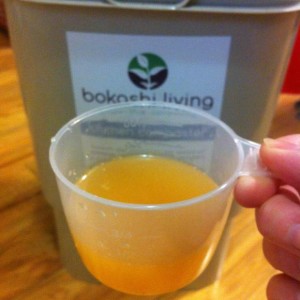 Bokashi tea, juice or leachate is the liquid that can be tapped from your bokashi kitchen composter. It contains a mixture of all the goodness from your bokashi kitchen composter; bokashi microbes, liquids from the food scraps and liquids produced during the fermentation process.
Bokashi tea, juice or leachate is the liquid that can be tapped from your bokashi kitchen composter. It contains a mixture of all the goodness from your bokashi kitchen composter; bokashi microbes, liquids from the food scraps and liquids produced during the fermentation process.
How can I use my bokashi tea?
Nutrient-rich fertilizer
Bokashi tea is a very nutrient rich fertilizer that can be used on your indoor plants or garden. This can be added to areas of your garden where it would be difficult to add bokashi pre-compost, such as on your lawn or in heavily planted areas.
Bokashi tea is quite acidic and therefore we recommend a dilution rate of around 1:100 before using. You may wish to test the dilution rate on sensitive plants and you may find that less sensitive plants can tolerate a lower dilution rate. The diluted bokashi tea fertilizer should be applied to the soil as the foliage will be more sensitive to high acidity levels.
Remember bokashi tea is teeming with the beneficial bacteria. We suggest you use your bokashi tea as soon as possible after draining it from your bokashi kitchen composter so that your plants can benefit from all of the goodness in it. If left unused for more than a few hours, then the tea may start to go bad…. and smell pretty awful.
Compost enhancer
Bokashi tea has millions of microbes from your bokashi compost bin. These can be incredibly beneficial to your compost pile. The bokashi tea can be poured directly into your compost pile.
The bacteria will help to speed up the composting process and is a great way to add moisture to your compost pile, if needed. Again, be sure to use fresh bokashi tea that you have just drained from your kitchen composter.
Drain unblocker
If you can’t use your bokashi tea straight away, don’t worry. You can simply poor it down the drain. It is completely natural and will not pollute. In fact, the bokashi bacteria can help to unblock clogged drains and are beneficial to the water treatment works too.
How soon should I get bokashi tea from my indoor kitchen composter?
This will depend on the materials that you are putting in your bokashi compost bin, but you will typically start to get bokashi tea after a couple of days. Don’t worry if it takes longer.
How much bokashi tea should I get?
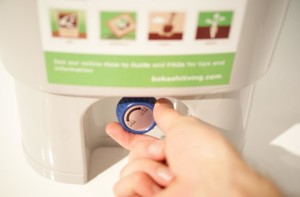 Again, this will depend on the food scraps that you are putting into your bokashi kitchen composter. If you are adding lots of juicy fruit peelings and rinds then you can expect to get more bokashi tea than if you are adding lots of dry items. On average you will likely see a couple of tablespoons every day or two at first, up to around 1-2 cups every day or two once your bokashi compost bin is full.
Again, this will depend on the food scraps that you are putting into your bokashi kitchen composter. If you are adding lots of juicy fruit peelings and rinds then you can expect to get more bokashi tea than if you are adding lots of dry items. On average you will likely see a couple of tablespoons every day or two at first, up to around 1-2 cups every day or two once your bokashi compost bin is full.
How does bokashi work: the science
Bokashi composting works by changing the biological and chemical structure of food waste through the fermentation process. During the fermentation process there is little visible change to the food scraps, other than the addition of white mold on the surface. However, the structure of the food waste has been altered such that it will break down in just two weeks when added to your garden. In addition, the pickling (or fermentation) of the food scraps means that they are no longer attractive to wildlife therefore allowing all food scraps to be composted at home without introducing pest problems.
Anaerobic versus aerobic
A traditional compost pile is broken down aerobically by microbes, bugs and fungi. As the process is aerobic, it is important to keep turning the materials regularly and allowing enough oxygen to get to the aerobic microbes. Should the process turn anaerobic (i.e., the pile is starved of oxygen) then it will start to putrefy and smell awful.
The bokashi bacteria, however, thrive in anaerobic conditions. By fermenting food in anaerobic conditions we allow the bokashi microbes to take over and suppress the nasty putrefying bacteria. No putrefying bacteria, no awful smell, swamp-like slime or harmful off-gassing.
What are bokashi EM (effective microorganisms)
EM (effective microorganisms) is a selected group of microbes that work together beneficially to ferment food waste. The original EM product (EM1) was developed by a Japanese researcher (Teruo Higa) in the 1980’s. By carefully selecting a mix of bacteria, Higa was able to develop a group of beneficial bacteria that are universally applicable and are able to survive (and thrive) in a wide range of real world conditions.
Today, there are different varieties of EM1-type products available. Whilst the exact microbes and the relative quantities of each may vary from product to product, the majority of bacteria in the EM culture will fall into the following three categories:
Lactic acid bacteria (LAM)
These bacteria convert sugar into lactic acid. This lactic acid production reduces the pH and produces an environment that is unfavorable for pathogens and methane-producing bacteria. Without this group of bacteria there would be no fermentation.
Yeast
Yeasts are single-cell fungi. Yeasts help to decompose sugars and create many beneficial by-products such as vitamins, hormones and amino acids.
Purple non-sulfur bacteria (PNSB)
PNSB microbes are able to survive in a wide variety of environments and this adaptability makes them a very useful group within any EM product. Their main benefit is in breaking down hydrogen sulphide gas and ammonia and reducing the odors associated with these gases.
Getting started with a bokashi composting system
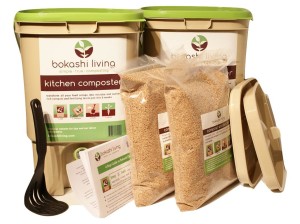 Bokashi composting offers a great solution for anyone looking to get the most out of their food waste. If you like what you’ve read then you can find all of the supplies you need to start your own bokashi compost system in our online shop (www.bokashiliving.com/shop).
Bokashi composting offers a great solution for anyone looking to get the most out of their food waste. If you like what you’ve read then you can find all of the supplies you need to start your own bokashi compost system in our online shop (www.bokashiliving.com/shop).
Where to find more information
Bokashi composting provides a quick, easy and pest free way to convert your food waste in just 4-6 weeks. It is widely used in Japan but is still relatively new to the rest of the world.
If you still have questions about bokashi then you can find lots more information on Bokashi Living’s website (www.bokashiliving.com). Alternatively, feel free to contact Bokashi Living directly (www.bokashiliving.com/contact-us); the team loves talking bokashi!
References
1 Green, L. A Pilot Study Comparing Gaseous Emissions Associated with Organic Waste Treated with and without Bokashi Fermentation. Case Study, 2009
Affiliate Disclosure
Bokashi Living.com has agreed to pay me a small commission for any sales they get from this article, so if you are wanting to support me and this site and get started with bokashi composting please use the links provided in this article.


